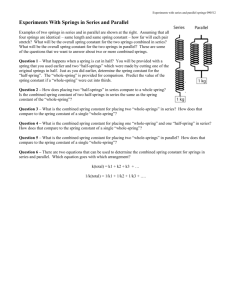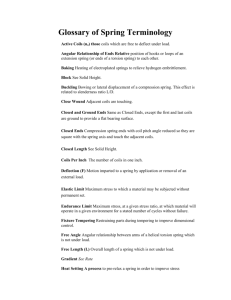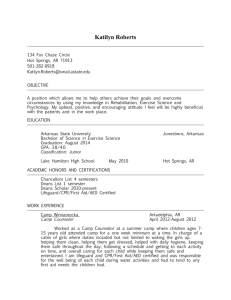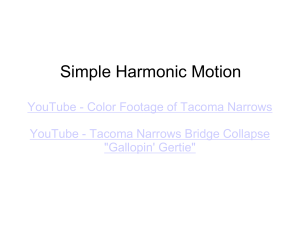basic spring design - Skegness Springs Ltd
advertisement
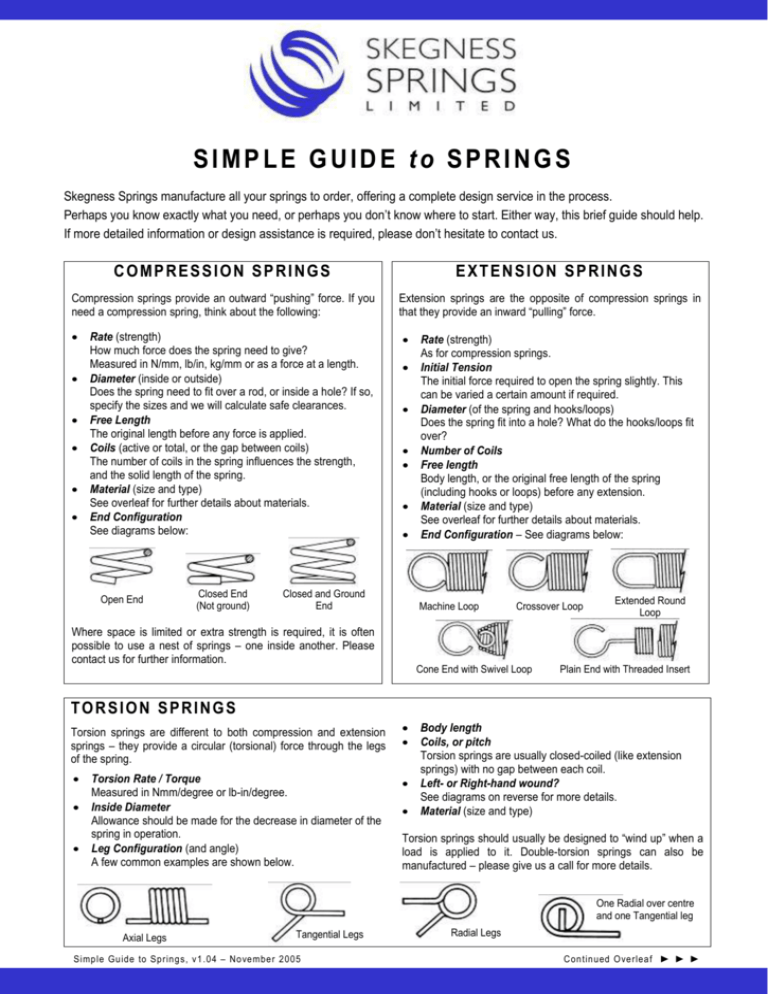
SIMPLE GUIDE to SPRINGS Skegness Springs manufacture all your springs to order, offering a complete design service in the process. Perhaps you know exactly what you need, or perhaps you don’t know where to start. Either way, this brief guide should help. If more detailed information or design assistance is required, please don’t hesitate to contact us. C O M P RE S S I O N S P RI NG S E X T E N S I O N S P RI N G S Compression springs provide an outward “pushing” force. If you need a compression spring, think about the following: Extension springs are the opposite of compression springs in that they provide an inward “pulling” force. Rate (strength) How much force does the spring need to give? Measured in N/mm, lb/in, kg/mm or as a force at a length. Diameter (inside or outside) Does the spring need to fit over a rod, or inside a hole? If so, specify the sizes and we will calculate safe clearances. Free Length The original length before any force is applied. Coils (active or total, or the gap between coils) The number of coils in the spring influences the strength, and the solid length of the spring. Material (size and type) See overleaf for further details about materials. End Configuration See diagrams below: Rate (strength) As for compression springs. Initial Tension The initial force required to open the spring slightly. This can be varied a certain amount if required. Diameter (of the spring and hooks/loops) Does the spring fit into a hole? What do the hooks/loops fit over? Number of Coils Free length Body length, or the original free length of the spring (including hooks or loops) before any extension. Material (size and type) See overleaf for further details about materials. End Configuration – See diagrams below: Open End Closed End (Not ground) Closed and Ground End Where space is limited or extra strength is required, it is often possible to use a nest of springs – one inside another. Please contact us for further information. Machine Loop Crossover Loop Cone End with Swivel Loop Extended Round Loop Plain End with Threaded Insert T O R S I O N S P RI NG S Torsion springs are different to both compression and extension springs – they provide a circular (torsional) force through the legs of the spring. Torsion Rate / Torque Measured in Nmm/degree or lb-in/degree. Inside Diameter Allowance should be made for the decrease in diameter of the spring in operation. Leg Configuration (and angle) A few common examples are shown below. Body length Coils, or pitch Torsion springs are usually closed-coiled (like extension springs) with no gap between each coil. Left- or Right-hand wound? See diagrams on reverse for more details. Material (size and type) Torsion springs should usually be designed to “wind up” when a load is applied to it. Double-torsion springs can also be manufactured – please give us a call for more details. One Radial over centre and one Tangential leg Axial Legs Tangential Legs Simple Guide to Springs, v1.04 – November 2005 Radial Legs Continued Overleaf ► ► ► F L AT S T RI P & W IR E S HA P E S We are able to manufacture an infinite range of flat and wire shapes to any design. Depending on the design and quantity required, these are manufactured either by hand, on automatic machines, or a combination of both. Full design assistance is available on request, but a few points to think about are listed opposite. Material Dimensions For flat strip we work up to about 3mm (0.116”) thick, in virtually any width and length. If possible, using standard thickness and widths can reduce costs considerably. Holes (size and position) Ensure the holes in the strip do not result in weakness. Diameters/Radii (on ends and corners) For circlips, specify the internal, or external, size the clip should fit into, or over. Bends (location and angles) Applicable to both wire and flat shapes. M AT E RI AL S E L E CT I O N U S E F UL CO NV E RS I O NS We stock a large range of standard spring steels, stainless spring steels and various alloys such as Inconels and Nimonics. The choice of material depends primarily on the application, and the level of corrosion resistance required. Force: 1kg = 2.20462lb = 9.80665N 1lb = 0.45359kg = 4.44822N 1N = 0.22481lb = 0.10197kg Carbon Spring Steels Usually specified to BS5216, this range of materials offer exceptional spring properties but a low level of corrosion resistance. Springs would usually be supplied oil-coated. Stainless Spring Steels We stock two main variants of BS2056 material – 302S26 and 316S42. Both offer good corrosion resistance and are ideal for use in “clean” environments such as food preparation areas, or medical applications. Nickel Alloys We stock a complete range of Inconel X750, a spring alloy ideally suited for use in petrochemical and hightemperature applications, along with other specialist alloys such as Nimonic 90 and Hastelloy C276. We also stock a large amount of less common materials including Beryllium Copper, Phosphor Bronze and Titanium. Please contact our design team for more information. Length: 1mm = 0.03937in 1in = 25.40mm Rate: 1N/mm = 5.7101lb/in 1lb/in = 0.1751N/mm Stress: 1N/mm² = 145.03774lb/in² = 1x106Pa 1lb/in² = 0.006894757N/mm² = 6894.76Pa 1Pa = 0.00014503774lb/in² = 1x10-6N/mm² We are happy to work with either Imperial or metric measurements, or a combination of both. Please ensure units and tolerances are clearly stated if required. L E F T & R I G HT HAN D Often, the direction a spring is wound is unimportant – but in some cases it is crucial. The diagrams below indicate the two “hands” – a right-hand spring will screw onto an ordinary thread: Left-hand Wound Right-hand Wound C O U NT I NG CO I L S If you are going to specify the dimensions of a spring, it is crucial that the number of coils is counted correctly, as this can have a huge effect on the strength of the spring. It is actually very straightforward, simply start at one end of the spring, where the wire has been cut, then follow the wire round – every time you go through 360º that counts as a full coil (180º = ½ coil; 90º = ¼ coil etc.) The compression spring pictured right has FIVE total coils (not six). The same method applies to extension springs and torsion springs. For more information about Skegness Springs and our range of products visit SKEGNESS SPRINGS LTD HASSALL ROAD SKEGNESS LINCOLNSHIRE PE25 3TB TEL +44(0)845 430 5000 FAX +44(0)1754 610584 www.skegsprings.co.uk


